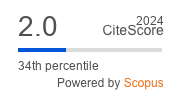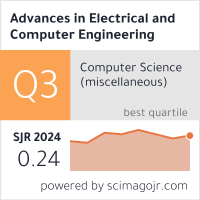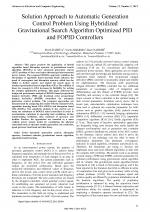| 2/2015 - 4 |
Solution Approach to Automatic Generation Control Problem Using Hybridized Gravitational Search Algorithm Optimized PID and FOPID ControllersDAHIYA, P. |
| Extra paper information in |
| Click to see author's profile in |
| Download PDF |
Author keywords
automatic generation control, disruption operator, fractional calculus, gravitational search algorithm, opposition based learning
References keywords
power(21), control(17), load(9), frequency(9), algorithm(9), generation(8), systems(7), automatic(7), system(6), search(5)
Blue keywords are present in both the references section and the paper title.
About this article
Date of Publication: 2015-05-31
Volume 15, Issue 2, Year 2015, On page(s): 23 - 34
ISSN: 1582-7445, e-ISSN: 1844-7600
Digital Object Identifier: 10.4316/AECE.2015.02004
Web of Science Accession Number: 000356808900004
SCOPUS ID: 84979725893
Abstract
This paper presents the application of hybrid opposition based disruption operator in gravitational search algorithm (DOGSA) to solve automatic generation control (AGC) problem of four area hydro-thermal-gas interconnected power system. The proposed DOGSA approach combines the advantages of opposition based learning which enhances the speed of convergence and disruption operator which has the ability to further explore and exploit the search space of standard gravitational search algorithm (GSA). The addition of these two concepts to GSA increases its flexibility for solving the complex optimization problems. This paper addresses the design and performance analysis of DOGSA based proportional integral derivative (PID) and fractional order proportional integral derivative (FOPID) controllers for automatic generation control problem. The proposed approaches are demonstrated by comparing the results with the standard GSA, opposition learning based GSA (OGSA) and disruption based GSA (DGSA). The sensitivity analysis is also carried out to study the robustness of DOGSA tuned controllers in order to accommodate variations in operating load conditions, tie-line synchronizing coefficient, time constants of governor and turbine. Further, the approaches are extended to a more realistic power system model by considering the physical constraints such as thermal turbine generation rate constraint, speed governor dead band and time delay. |
| References | | | Cited By «-- Click to see who has cited this paper |
| [1] H. Saadat, Power system analysis, 2nd ed. New Delhi, India: TMH, pp. 551, 2002.
[2] Ibraheem, P. Kumar, D.P. Kothari, "Recent philosophies of automatic generation control strategies in power systems," IEEE T Power Syst, Vol. 20, No. 1, pp. 346-57, Feb. 2005. [CrossRef] [SCOPUS Times Cited 801] [3] H. Shayeghi, H.A. Shayanfar, A. Jalili, "Load frequency control strategies: A state-of-the-art survey for the researcher," Energ Convers Manage, Vol. 50, No. 2, pp. 344-353, Feb. 2009. [CrossRef] [SCOPUS Times Cited 508] [4] S.K. Pandey, R.M. Soumya, N. Kishor, "A literature survey on load-frequency control for conventional and distribution generation power systems," Renew Sust Energ Rev, Vol. 25, pp. 318-334, Sep. 2013. [CrossRef] [SCOPUS Times Cited 522] [5] S.J.P.S. Mariano, J.A.N. Pombo, M.R.A. Calado, L.A.F.M. Ferreira, "A procedure to specify the weighting matrices for an optimal load-frequency controller," Turk J Electr Eng Co, Vol. 20, No. 3, pp. 367-379, 2012. [CrossRef] [SCOPUS Times Cited 9] [6] N. Hasan, Ibraheem, P. Kumar, N. Nizamuddin, "Sub-optimal automatic generation control of interconnected power system using constrained feedback control strategy," Int J Elec Power, Vol. 43, No. 1, pp. 295-303, Dec. 2012. [CrossRef] [SCOPUS Times Cited 33] [7] A. Demiroren, N.S. Sengor, H.L. Zeynelgil, "Automatic generation control by using ANN technique," Electr Pow Compo Sys, Vol. 29, No. 10, pp. 883-896, 2001. [CrossRef] [SCOPUS Times Cited 84] [8] A. Zavoianu, G. Bramerdorfer, E. Lughofer, S. Siber, W. Amrhein, E.P. Klement, "Hybridization of multi-objective evolutionary algorithms and artificial neural networks for optimizing the performance of electrical drives," Eng Appl Artif Intel, Vol. 26, No. 8, pp. 1781-1794, Jun. 2013. [CrossRef] [SCOPUS Times Cited 89] [9] E. Cam and I. Kocaarslan, "Load frequency control in two area power systems using fuzzy logic controller," Energ Convers Manage, Vol. 46, No. 2, pp. 233-243, Jan. 2005. [CrossRef] [SCOPUS Times Cited 186] [10] M.I. Alomoush, "Load frequency control and automatic generation control using fractional order controllers," Electr Eng, Vol. 91, No. 7, pp. 357-368, Jan. 2010. [CrossRef] [SCOPUS Times Cited 119] [11] H. Shayeghi, A. Jalili, H.A. Shayanfar, "Multi-stage fuzzy load frequency control using PSO," Energ Convers Manage, Vol. 49, No. 10, pp. 2570-2580, Oct. 2008. [CrossRef] [SCOPUS Times Cited 161] [12] F. Valdez, P. Melin, O. Castillo, "An improved evolutionary method with fuzzy logic for combining particle swarm optimization and genetic algorithms," Appl Soft Comput, Vol. 11, No. 2, pp. 2625-2632, Mar. 2011. [CrossRef] [SCOPUS Times Cited 210] [13] N. A. El-Hefnawy, "Solving bi-level problems using modified particle swarm optimization algorithm," Int J Artificial Intelligence, Vol. 12, No. 2, pp. 88-101, Oct. 2014. [14] E.S. Ali, S.M. Abd-Elazim, "Bacteria foraging optimization algorithm based load frequency control for interconnected power system," Int J Elec Power, Vol. 33, No. 3, pp. 633-638, Mar. 2011. [CrossRef] [SCOPUS Times Cited 461] [15] U.K. Rout, R.K. Sahu, S. Panda, "Design and analysis of differential evolution algorithm based automatic generation control for interconnected power system," Ain Shams Eng J, Vol. 4, No. 3, pp. 409-421, Sep. 2013. [CrossRef] [SCOPUS Times Cited 268] [16] H. Shabani, B. Vahidi, M. Ebrahimpour, "A robust PID controller based on imperialist competitive algorithm for load-frequency control of power systems," ISA T, Vol. 52, No. 1, pp. 88-95, Jan. 2013. [CrossRef] [SCOPUS Times Cited 310] [17] S. Debbarma, L.C. Saikia, N. Sinha, "Automatic generation control using two degree of freedom fractional order PID controller," Int J Elec Power, Vol. 58, pp. 120-129, Jun. 2014. [CrossRef] [SCOPUS Times Cited 215] [18] E. Rashedi, H. Nezamabadi-pour, J.S. Saryazdi, "GSA: a gravitational search algorithm," Inform Sciences, Vol. 179, No. 13, pp. 2232-2248, Jun. 2009. [CrossRef] [SCOPUS Times Cited 6556] [19] R.K. Sahu, S. Panda, S. Padhan, "Optimal gravitational search algorithm for automatic generation control of interconnected power systems," Ain Shams Eng J, Vol. 5, No. 3, pp. 721-733, Sep. 2014. [CrossRef] [SCOPUS Times Cited 178] [20] R. E. Precup, R. C. David, E. M. Petriu, S. Preitl, A. S. Paul, "Gravitational search algorithm-based tuning of fuzzy control systems with a reduced parametric sensitivity," Series: Soft Computing in Industrial Applications, Advances in Intelligent and Soft Computing, Vol. 96, pp. 141-150, 2011. [CrossRef] [SCOPUS Times Cited 80] [21] S. Rahnamayan, H.R. Tizhoosh, M.M.A. Salama, "A novel population initialization method for accelerating evolutionary algorithms," Comput Math Appl, Vol. 53, No. 10, pp. 1605-1614, May 2007. [CrossRef] [SCOPUS Times Cited 312] [22] B. Shaw, V. Mukherjee, S.P. Ghoshal, "A novel opposition-based gravitational search algorithm for combined economic and emission dispatch problems of power systems," Int J Elec Power, Vol. 35, No. 1, pp. 21-33, Feb. 2012. [CrossRef] [SCOPUS Times Cited 239] [23] S. Sarafrazi, H. Nezamabadipour, S. Saryazdi, "Disruption: a new operator in gravitational search algorithm," Sci Iran, Vol. 18, No. 3, pp. 539-548, Jun. 2011. [CrossRef] [SCOPUS Times Cited 166] [24] A.W. Berger, F.C. Schweppe, "Real time pricing to assist in load frequency control," IEEE T Power Syst, Vol. 4, No. 3, pp. 920-926, Aug. 1989. [CrossRef] [SCOPUS Times Cited 105] [25] I.C. Report, "Dynamic model for steam and hydro turbines in power system studies," IEEE T Power Ap Syst, Vol. PAS-92, No. 6, pp. 1904-1915, Nov. 1973. [CrossRef] [SCOPUS Times Cited 808] [26] I.W.G. Report, "Dynamic models for fossil fuelled steam units in power system studies," IEEE T Power Syst, Vol. 6, No. 2, pp. 753-761, May 1991. [CrossRef] [SCOPUS Times Cited 296] [27] W.I. Rowen, "Simplified mathematical representation of heavy duty gas turbine," J Eng Gas Turb Power, Vol. 105, No. 4, pp. 865-870, Oct. 1983. [CrossRef] [SCOPUS Times Cited 592] Web of Science® Citations for all references: 0 SCOPUS® Citations for all references: 13,308 TCR Web of Science® Average Citations per reference: 0 SCOPUS® Average Citations per reference: 475 ACR TCR = Total Citations for References / ACR = Average Citations per Reference We introduced in 2010 - for the first time in scientific publishing, the term "References Weight", as a quantitative indication of the quality ... Read more Citations for references updated on 2025-07-01 00:59 in 165 seconds. Note1: Web of Science® is a registered trademark of Clarivate Analytics. Note2: SCOPUS® is a registered trademark of Elsevier B.V. Disclaimer: All queries to the respective databases were made by using the DOI record of every reference (where available). Due to technical problems beyond our control, the information is not always accurate. Please use the CrossRef link to visit the respective publisher site. |
Faculty of Electrical Engineering and Computer Science
Stefan cel Mare University of Suceava, Romania
All rights reserved: Advances in Electrical and Computer Engineering is a registered trademark of the Stefan cel Mare University of Suceava. No part of this publication may be reproduced, stored in a retrieval system, photocopied, recorded or archived, without the written permission from the Editor. When authors submit their papers for publication, they agree that the copyright for their article be transferred to the Faculty of Electrical Engineering and Computer Science, Stefan cel Mare University of Suceava, Romania, if and only if the articles are accepted for publication. The copyright covers the exclusive rights to reproduce and distribute the article, including reprints and translations.
Permission for other use: The copyright owner's consent does not extend to copying for general distribution, for promotion, for creating new works, or for resale. Specific written permission must be obtained from the Editor for such copying. Direct linking to files hosted on this website is strictly prohibited.
Disclaimer: Whilst every effort is made by the publishers and editorial board to see that no inaccurate or misleading data, opinions or statements appear in this journal, they wish to make it clear that all information and opinions formulated in the articles, as well as linguistic accuracy, are the sole responsibility of the author.



